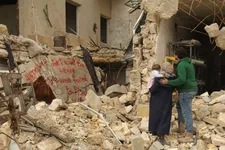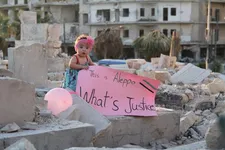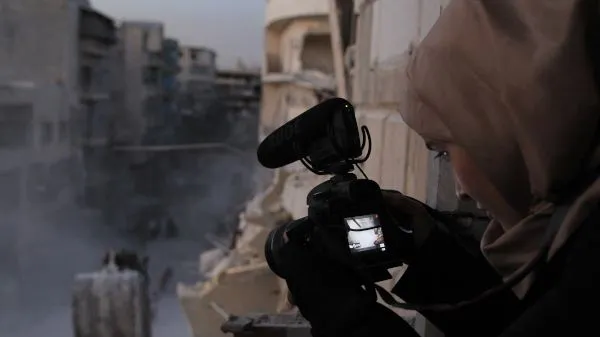 |
| Waad al-Kateab filming the ruins of a building destroyed by bombing in besieged east Aleppo, October 2016. Photo: courtesy of PBS Distribution, copyright Waad al-Kateab |
Syrian documentary For Sama - directed by Waad al-Kateab and Edward Watts - stems from footage al-Kateab began to shoot on her mobile phone to document protests in her homeland in 2012. From those small beginnings, came work with Channel 4 News, in 2016, on a series of films called Inside Aleppo, as the conflict between the rebels and the regime of Bashar al-Assad and his Russian allies deepened. Now the film she has created with Watts from the hours of footage she shot in the city before she and her husband Hamza and their daughter Sama - to whom the film is addressed - were evacuated from in December 2016, offers a female perspective in a documentary area that has previously been dominated by male voices.
The film, in particular, shows the experience of motherhood under the threat of bombardment and charts the merciless targeting of medical facilities by the Syrian regime. I caught up with al-Kateab - who now lives in London with her family - and British director Watts ahead of the film's release in the US on July 26 (to be followed by a UK release on September 13 to talk about making the film in a warzone and the impact campaign they are busy creating to raise awareness of the ongoing situation in Syria.
Tell me about how the pair of you came to work together on the project.
Edward Watts: It starts with Waad and she was doing all this stuff for Channel 4 News. But no one knew she had this incredible archive until she left and, literally, was displaced from Aleppo and brought these hard drives with these hundreds of hours of footage. And when she went to meet our colleagues in London, she showed them all this footage and was saying she wanted to make a film out of it.
They basically match-made use because they knew I was passionate about Syria and I'd long wanted to make a documentary that wasn't about ISIS but that was about the original Syrian revolutionaries, the people who started the protests right at the beginning. Because of my experience of doing long-form documentaries, it seemed like I'd be a good collaborator for her, so we met two years ago and our collaboration grew from there.
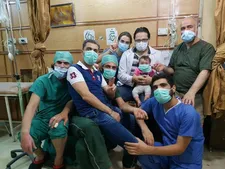 |
| Hamza, Sama and the staff of al-Quds hospital, which Hamza set up in 2012 in east Aleppo Photo: courtesy of PBS Distribution, copyright Waad al-Kateab |
How was it for you Waad to collaborate because it's a very personal thing for you, to share that work with someone else?
Waad al-Kateab: When I left, I just wanted to do something to bring justice to the story that I had lived through. For me, I just felt, I wasn't able to do that alone. I had lost everything and I was very involved in the story, I couldn't judge exactly what I wanted to do. I wanted someone else's opinion to help me make the decisions. And when we started with Ed, it took some time to understand each other but, let's say, at the end of this process, we were speaking the same language. It's about how we trust each other, not just as directors but as a family and we shared a lot of the same passion about the story and about presenting the film in the best way. We were match-made, but in the end it was a great destiny because it founded a great relationship.
It was very important for me, as a Syrian, to document the crimes that were happening, so from the beginning I wanted to go beyond the news. It was just for documenting every case that came to the hospital in order to bring justice later. So when we were watching the footage, we had a discussion about what line would keep people watching the film and to help them understand the horror of the situation but to make it acceptable for them to watch the film up to the end.
It doesn't pull its punches in places. Was that something that you were conscious of too, Edward, that you wanted to keep the audience with you? That you didn't want it to become so graphic that people couldn't watch?
EW:That was one of the most important things that I brought to the whole project - just trying to distil this extraordinary archive and the horror into a form that would keep and engage an audience and not overwhelm them. We wanted to tell a story in a way that would engage their emotions and, if they made it through to the end, they'd have learned a hell of a lot about Syria as well as about humanity. One of the reasons why the process took so long, was getting that balance right.
The other thing, though, was that we definitely did want to show some of it - that was a decision that we'd taken - that we weren't going to shield people completely from the horror. So trying to find that balance was one of the things that was so difficult. There were early cuts of the film. There was one, in particular, that we showed to friends and family and we'd gone with too much - they, literally, were saying, 'We can't take this, it's overwhelming'. So we pulled that back. Also, within the stuff we did include, we tried to include images and stories that were bearable. Some of the things that Waad shot, were so gruesome, horrific and graphic. So we tried to find scenes that would convey the horror but without being so full on that people's minds would shut down.
 |
| For Sama director Waad al-Kateab Photo: Zahed Katurji |
It must have been quite traumatic to have to go through the footage for the film after having lived through it?
WA: Fortunately, the story of me and my family is ended and we are survivors. But for us, as Syrians, it hasn't finished. There's a feeling that it's still going on and it gives us a lot of responsibility that we should do this and make it in the best way, so people can really engage with it and care about the situation right now. As we speak, it's still happening in a place called Idlib and this, for me, is a big responsibility to keep telling the story and give people a chance to really understand the situation. Hopefully, we can make a big difference in people's lives. It was very difficult but, at the same time, very important.
Are there things that you hope people will do as a result of seeing the film?
EW: We're building an impact campaign. We have a screening at the UN next week, we are also doing a briefing, sponsored by the UK mission. We're building this impact campaign, which will have, as part of it, a series of individual actions that people can do to help the situation and keep Syria in the news and keep international public pressure on the Russians and the regime.
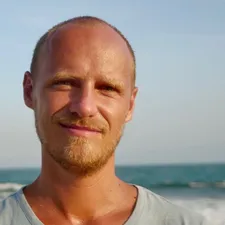 |
| For Sama director Edward Watts Photo: Olivia Scarlett |
WA: It's about practical actions.
EW: One of our focuses is to stop the bombing of hospitals. The medical facilities issue is one of our primary focuses, because obviously it relates very strongly to the film. I think in the past month or so, 26 medical facilities have been destroyed. One of the things that has been so brilliant is that, through the course of making the film, people were saying to us, 'You know, people are tired of Syria now and it's been in the news so long that this film is unlikely to break through'. But not only has the film had this amazing reaction and gone to all different places around the world, from Cannes to Nantucket to Sheffield, but also, at the end of it, wherever we are, the people say, 'What can we do?' So despite the years of this and people being exhausted by the whole Syrian conflict, because of the emotion and the intimacy of the film, I think, and the humanity that's in it, it's re-engaging people with the subject and reinspiring them to say, 'What can we do to help.'
PBS Distribution will release For Sama in the US from July 26. Republic Film Distribution will release For Sama in the UK from September 13. For more information about the film, visit the official site.
Watch the trailer:-








